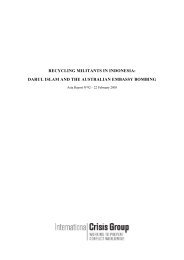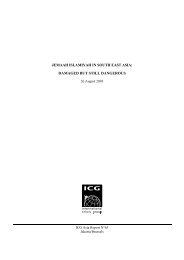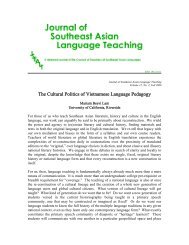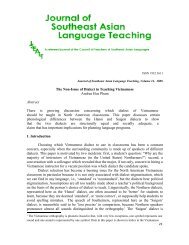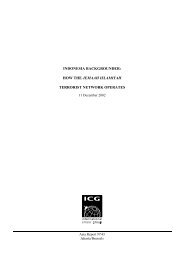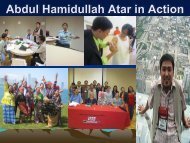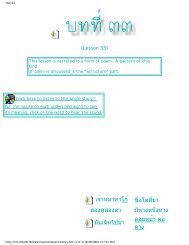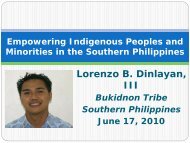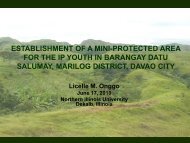Introduction - SEAsite - Northern Illinois University
Introduction - SEAsite - Northern Illinois University
Introduction - SEAsite - Northern Illinois University
You also want an ePaper? Increase the reach of your titles
YUMPU automatically turns print PDFs into web optimized ePapers that Google loves.
Prentation Abstracts<br />
lescents to rate their parents, Intergenerational Conflict Inventory: Adolescent’s<br />
version (ICI-A), and the Center for Epidemiological Studies Depression Scale for<br />
Children (CES-DC). Due to the language barriers, the Laotian parents were orally<br />
administered two scales the AAMAS, and Intergenerational Conflict Inventory:<br />
Adolescent’s Parent Version (ICI-P).<br />
The following hypotheses are based on the scales listed herein that will be<br />
administered in the study: 1) There will be significant differences between the<br />
adolescent’s self-reported acculturation and their parent’s self-reported acculturation<br />
levels. 2) There will be no significant difference between the adolescents’<br />
perceptions of the parents’ acculturation level vs. the parents self-reported acculturation<br />
level. 3) The greater the difference in the self-reported acculturation<br />
levels between the adolescents and their parents, the higher the likelihood of the<br />
intergenerational conflicts rated by both of them... 4) The greater the difference in<br />
the self-reported acculturation levels between the adolescents and the parents, the<br />
higher the likelihood that the adolescents would report symptoms of depression.<br />
5) The higher the likelihood of the intergenerational conflicts rated by adolescents<br />
and the parents, the higher the likelihood that adolescents would report symptoms<br />
of depression.<br />
*Lao in this paper refers to all ethnic groups from Laos (e.g. Hmong, Mien,<br />
Khamu, Tai Lue, Tai Dam, etc.)<br />
Douang Deuane Bounyavong<br />
Research work on Thao Hung Epic by Maha Sila Viravongs:<br />
Comparative Study of the Political Ideology Expressed in Thao<br />
Hung Epic<br />
Researcher on Lao Literature and Textiles, Maha Sila Viravongs Library, Lao<br />
PDR<br />
This paper has two parts. The first focused on the research work done by Maha<br />
Sila Viravongs during the 1940’s. How he came to discover the palm leave document<br />
of this great historical Epic of Thao Hung at the Thai National Library in<br />
Bangkok where he lived in exile. The original manuscript comprised of more than<br />
300 leaves tied together into bundles. When Maha Sila found the bundles of palm<br />
leaves, they were not in good condition enough to be readable. Maha Sila spent<br />
almost a year to read the work and transliterated into Thai script. He has tried to<br />
arrange line by line of the story in poem pattern and found out that the poems were<br />
composed of many kinds of verses. As many pages were missed, the story was<br />
not completed, so it could be not comprehensible by readers. When he returned to<br />
Laos later on, Maha Sila went toward his work and discovered others versions of<br />
Thao Hung story. Once he understood the complete story, he was trying to fill up<br />
the missing part by adding his own poem. This very missing part is about the birth<br />
of Thao Hung and his brother. Therefore Maha Sila made up the story about the<br />
birth of the twin brothers: Thao Hung and his elder brother Thao Huing.<br />
The second part is a comparative study of the political ideology expressed in<br />
the epic. It focused on the interaction between the neighbor kingdoms, the customs<br />
and believes of people, the ideal quality of the political leaders and the factors<br />
involved in the legitimacy process of the kingship and role and duty of political<br />
leader. The study referred to: the Atom –Buranji. “From the earliest time to the end<br />
of Ahom rule,” the Xieng Tung (Chiangtung) chronicle of Tai’Kheun in the Shan<br />
state of Myanmar, the Yonok or Xieng Sene (Chiangsene); chronicles of Lanna<br />
and the Khun Borom of Lanxang.<br />
This approach to anthropological and historical study referred to local documents<br />
of different sources enables us to understand better some aspects of the<br />
history such as the very close relationship between the indigenous and Lao-Tai’<br />
ethnic who is newcomer, the intercultural exchange among them in the period<br />
prior Indian influence etc. The Ahom Buranji composed in local language told us<br />
that the God or Lord of Thunder has sent his two nephews to rule the earth and<br />
govern T’ai people. This legendary ancestor’ s story is similar to that of Lao-Tai<br />
ethnic in Lanna and Lanxang kingdom. The comparative study found that the T’ai<br />
in Ahom or Asam state of India , the T’ai Kheun in Shan state of Myanmar, the<br />
T’ai Lao in Laos and Thailand worshiped the same God or Lord of Thunder by<br />
scarifying elephant, cow and water buffalo. There are also other common deities<br />
and local spirits.<br />
The interaction among neighboring kingdoms based on the marriage between<br />
the crown prince and prices of other state. It was also found that the intermarriage<br />
between a brother and half sister or a relative ‘s member (second cousin<br />
) among royal families is widely practiced. It is clear that this intermarriage is a<br />
very important factor involved in the extending policy of conquest, territory annexation.<br />
A person of ordinary rank who became a son in law of a powerful king<br />
could make himself a legitimate heir or seized directly or indirectly the throne. The<br />
daughter of a political leader or princess enjoyed her role of peacemaker as well<br />
as conflict and war cause. This social value role of ruling class women reflected in<br />
other daily life such as the followings: the equal right of inheritance for both male<br />
and female descendents, the female medium spirit for workshop ceremony and<br />
protected spirits. Our local chronicles and legends portrayed this women’s role in<br />
accordance with historical documents.<br />
For the cultural characteristics of South East Asian people, it is interesting to<br />
include the knowledge in horoscopy. Indigenous and Lao-T’ai people believed in<br />
the prediction of future by an examination of the chicken leg bone. In a ceremony<br />
called Riak-Khuane in Asam a Su-Khuane in Laos, one can note that the boiled<br />
chicken is placed among others foods and offering items. When the shaman or the<br />
elder folk who presided the ceremony ended his prays, the bone of the chicken leg<br />
and mouth would be carefully examined and the specialist (shaman) will predict<br />
the future of the Sukhuane’s owner. The Ahom Buranji and Thao Hung epic, both<br />
semi local chronicle semi legendary documents, elaborated this custom if they<br />
were composed by the same hand. The interpretation of dreams and omens seemed<br />
to be one of the powerful means to legitimate the kinship. Its influence among<br />
Lao-T’ai people still continued to persist up to present time.<br />
Yes, there is any doubt about Lao-T’ai believes. The God named Lord of<br />
Thunder who reigned in his realm came into communication with people through<br />
the medium spirit. The ruler or political; evader was considered as a descendent<br />
of this God or Thaen. In the early period of state formation, the rulers of brother<br />
kingdoms originated from the same family. They were brothers and cousins. Being<br />
descendent of Thaen means to be invincible. In this early period of political<br />
centralization, the local ruler had to lead by himself any kinds of construction<br />
works such as irrigation canals, bridges, city wall, and palaces. The greatness and<br />
authority of the king necessitated in a number of labor force and population who<br />
will contribute by paying taxes for the wealth of the kingdom. The content of<br />
teachings and advices given by Lord of Thunder or by the king to their subjects,<br />
showed that the rulers had to apply a policy which much satisfy his population.<br />
This is quite interesting to note that the capital punishment did exist in that time.<br />
It was prescribed against male culprit who raped or robed or usurped women’s<br />
properties. Punishment of culprit women is remarkably less severe than the male<br />
case. Comparing with the contents of the Thai Thammasat (14-18 century) and the<br />
royal Orders of Burma (from 13th century) it was found that the tuning point in<br />
this matter is very concerned with political and social role of women.<br />
Kara Burnett, Ed.D.<br />
The Power of Narrative: Students Daring to Dream in Lao PDR<br />
<strong>University</strong> of San Francisco, California<br />
Research Issue:<br />
Young adults in Laos, as they complete school and attempt to enter the workforce,<br />
experience the traditional challenges of this transition accompanied by challenges<br />
by living in an economically developing nation. This research identifies the places<br />
selected Lao students inhabit as they explore who they are, and who they may<br />
be becoming, i.e. their identity. Identity development (Ricoeur 1992) is formed<br />
through narrative. Telling one’s story bridges life’s stages, whether they refer to<br />
age, or cultural and economic changes. This research seeks to interpret selected<br />
Lao students’ stories of their past, their present, and how they envision and plan<br />
their future. The purpose of this research is to ferret out policy recommendations<br />
that may serve to strengthen and broaden the Lao education system.<br />
Research Process:<br />
This research is grounded in critical hermeneutic participatory theory (Herda<br />
1999) supported by concepts of understanding and narrative identity (Ricoeur<br />
1992). Three categories used for data collection and analysis are Mimesis1, figuration:<br />
reflection and remembering the past, Mimesis2, configuration: narrative<br />
employment, and Mimesis3, refiguration: imagining the future. Data were collected<br />
through both formal and informal conversations with selected participants<br />
at Lao American College in Vientiane, Laos. Transcriptions of the conversations<br />
provided the text for analysis. This process offered the researcher opportunities to<br />
work collaboratively with Lao students to explore the present and reflect on the<br />
past and future.<br />
Research Implications:<br />
Lao students are aware that the Lao way of life is slow to change in light of the<br />
development process. They know their country compares unfavorably, in terms of<br />
socioeconomic development, to some of their neighbors. They see an education






